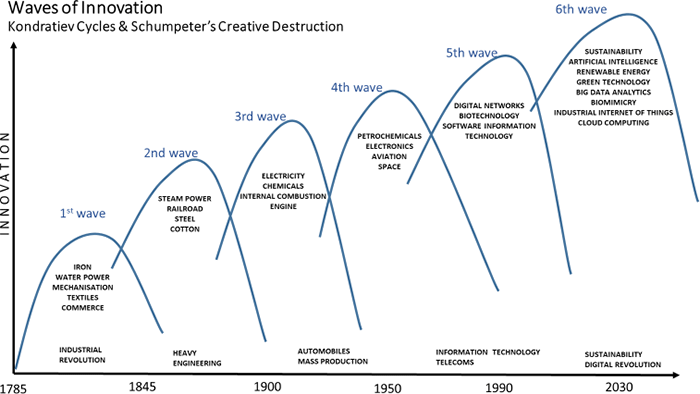Creative Destruction — How to Prepare for the Paradigm Shift
The concept in economic theory to describe new innovations that replace and make older innovations obsolete. Welcome to Ocean Protocol, aka the creative destruction tool of the 21st century and the New Data Economy.

Background
The term ‘Creative Destruction’ was first claimed as a subset of Marxism by Karl Marx, but readily identified a century later by Austrian economist Joseph Schumpeter. Creative Destruction is the dismantling of long-standing practices in society and business, in order to make way for innovation, and is seen as a driving force of revolutionary change in a capitalist world.
Principles of Creative Destruction:
- Innovation: Creative destruction involves the introduction of new ideas, products, and technologies that replace the existing ones. Innovation is the driving force of creative destruction. Without innovation, creative destruction could not exist and without innovators, there would be no change agents that could make creative destruction happen.
- Competition: The process of creative destruction involves intense competition between old and new technologies or products. The new products or technologies must prove to be better and more efficient than the old ones to replace them. For this reason, creative destruction is usually heavily tied to competition and competitive advantages. Companies usually strive to find the best ways to do things and are often willing to creatively destroy what they’ve done in the past to find better long-term solutions.
- Entrepreneurship: Entrepreneurship is also critical to the process of creative destruction. The entrepreneurs who develop new products and technologies and disrupt existing markets are the agents of creative destruction. They are responsible for overseeing change management and educating both internal staff and consumers on how this change will impact them. Without clear guidance on the intention of the creative destruction, the entrepreneur will likely fail in their attempt to innovate.
- Capital: A cornerstone principle of creative destruction is capital. Making sweeping, radical innovative changes is often expensive, and companies must be prepared to take on financial risks to make this change. Most often, companies will see venture capital investments to aid with funding the creative destruction.
Ocean Protocol
You may have heard the phrase in 2023 that ‘Data is the new oil’. The rise of globalization, e-commerce, and cross-border information sharing has led to the majority of companies globally needing a digital presence, if not functioning entirely digitally. A key driver of creative destruction in the modern economy is data. Data is the backbone of emerging industries such as artificial intelligence, machine learning, and the Internet of Things. However, the current ‘data economy’ is centralized and fragmented. Right now it is quite difficult for businesses to access and use the data they need to innovate and grow. Ocean Protocol provides the solution to this problem and is the pioneer of the New Data Economy.
Fragmented data is where we lie at the time of this writing. Before this issue, platforms and services such as Shopify, Stripe, Amazon, and eBay captured product market fit for tailoring to innovation, entrepreneurship, and competition, as mentioned above in the principles of creative destruction.
Ocean Technology is already being used by a variety of businesses to power data-driven innovation. For Example, Acentrik, a strategic product by Mercedes Benz, is poised to enable cross-border data exchange and allow organizations to fully unlock and leverage data for new value streams. The smartwatch & wearable health company Brainstem leverages Ocean Protocol technology to allow users to own, monetize, and share their health data generated by the smartwatch.
Ocean Protocol was founded with a thesis to level the playing field for AI and data. The protocol is an open-source suite of tools to power the New Data Economy. Primary resources that can be used by anyone in beginning their journey in conducting commerce and business in the new age include a javascript library, ocean.js, python library, ocean.py, and a smart contract library, see here. A core function of Ocean Protocol is the Ocean Market, a marketplace to share data privately and securely. The market is forkable and can be used in a closed or open-source fashion for data-sharing purposes across enterprises, DAOs, social contexts, or open government data.
Web3 is about solving business problems. This statement can sound contradictory to the last 18 months of bad actors, stolen funds, and manipulated token price markets. Over the past 18 months in the traditional enterprise space, interest in leveraging blockchain technology and crypto-native payment rails to improve efficiency, reduce costs, and improve the speed of innovation hasn’t gone away.
Historical Examples of Creative Destruction
This is in anticipation that we are replacing the internet with the blockchain. For the context of a specific paradigm shift, let’s look back at some prominent examples of creative destruction throughout business history:
1. The Automobile Replacing the Horse-Drawn Carriage
Old Technology: Horse-drawn carriages
New Technology: Automobiles
Background:
In the late 19th and early 20th centuries, horse-drawn carriages were the primary means of urban transportation. Cities were structured around the needs of horses, with stables, troughs, and blacksmith shops being common urban services.
The Shift:
- Innovation: In the late 1800s and early 1900s, innovators and entrepreneurs like Karl Benz, Henry Ford, and Ransom Olds began developing gasoline-powered vehicles. The Model T, introduced by Ford in 1908, was especially revolutionary because of its affordability and the adoption of assembly-line production.
- Impact on the Old Industry: As automobiles became more affordable and reliable, the demand for horse-drawn carriages plummeted. Blacksmiths, carriage makers, and stable owners found their trades becoming obsolete. Cities transformed, with paved roads, gas stations, and repair shops replacing horse-centric infrastructure.
- Economic and Social Implications: The automobile industry's rise created millions of jobs, from manufacturing to sales to infrastructure development. Suburbs became feasible due to increased mobility, changing the very structure of urban and suburban life. However, there were also negative externalities, such as pollution, traffic fatalities, and urban sprawl.
2. Digital Photography Overtaking Film Photography
Old Technology: Film-based cameras and photography
New Technology: Digital cameras and photography
Background:
For over a century, photography was dominated by film. Companies like Kodak and Fujifilm produced photographic films and paper, and the process of taking photos involved capturing images on film, developing the film in a dark room, and then printing photos on paper.
The Shift:
- Innovation: The first digital cameras were developed in the 1970s and 1980s, but it wasn’t until the 1990s and 2000s that they became widely accessible and affordable to the general public. These cameras captured images electronically, allowing for immediate viewing and easy sharing and editing on computers.
- Impact on the Old Industry: The rise of digital photography led to a rapid decline in the demand for film. By the 2000s, sales of film cameras had dramatically decreased, and many film manufacturers either went out of business or pivoted to other areas. Notably, Kodak, once a giant in the photography industry, filed for bankruptcy in 2012, largely due to its failure to adapt quickly to the digital age.
- Economic and Social Implications: The digital revolution transformed the photography industry. It became cheaper and more accessible for individuals to take and share photos, leading to the rise of platforms like Instagram and Snapchat. New business models emerged, including stock photo websites and online photo printing services. However, traditional photo labs, film manufacturers, and related businesses faced significant challenges or closure.
In both cases, the new technologies brought about vast economic and societal changes, demonstrating the dual nature of creative destruction: the decline of old industries and the rise of new, often transformative, ones. People still drive but in cars and not horses. People still take photos, but digitally and not by film.
For the NEXT creative destruction event, people will still use the internet, but they will own their data and online presence.
About Ocean Protocol
Ocean was founded to level the playing field for AI and data. Ocean tools enable people to privately & securely publish, exchange, and consume data.
Follow Ocean on Twitter or Telegram to keep up to date. Chat directly with the Ocean community on Discord. Or, track Ocean progress directly on GitHub.

